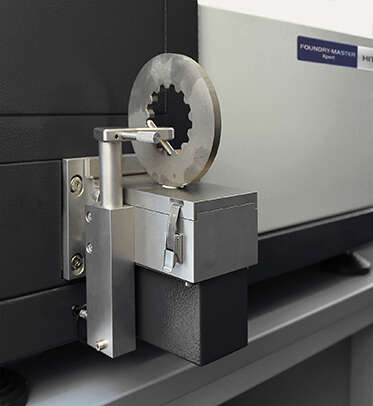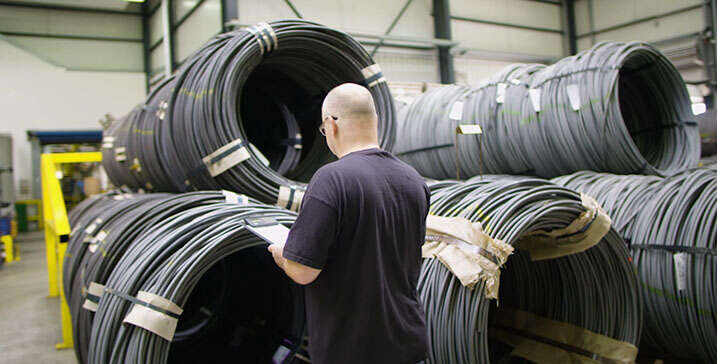There’s no doubt that today’s OES analyzers form an essential part of quality control for metals processing facilities. However, integrating an OES analyzer so it becomes a seamless part of your quality control can create challenges and obstacles that need to be overcome. Here, we’ve presented seven common problems that manufacturers tell us they’ve had when starting to use a new machine.
To get an accurate and reliable OES result, the spark stand of the analyzer must form a complete seal with the surface of the metal to be measured. If air is allowed to enter the space where the spark is generated, you will get incorrect results. This can be apparent when manufacturers try to measure fiddly shapes with a small surface area – in these cases it can be almost impossible to get a good contact between the sample and the spark stand.
The solution
The spark stand can be fitted with an adaptor to reduce the sparks stand hold diameter and make it easier to get a good contact on small, irregular or complex shapes. Hitachi’s OES range offers adaptors to measure wires down to 3 mm in diameter. Furthermore, our stationary OES has a spark stand which is accessible from three sides, making positioning of samples with irregular shapes possible.

Some regulations demand extremely low limits of detection with OES for conformance. An example of this is the ASTM E415 specification that controls nitrogen levels in steel. This requires an OES instrument that can analyze gasses to below 10 ppm.
The solution
Unfortunately, this is down to the capability of the analyzer itself, and our advice is to ensure that your analyzer will meet the norms and regulations prior to purchase. Of course, regulations get tighter all the time, and ensuring you choose an instrument with the best possible performance for the price helps you get the most from your investment.
Two significant operating costs for OES are power and argon use. They can really add up over time, especially if you are using your OES for 100 % testing.
The solution
Hitachi’s OE series of spark spectrometers include a spark stand that’s optimized for low argon consumption and operates at around 10% of the power of previous models.
Analytical best practice demands that you calculate the error margin for your measurements – it’s a requirement of many standard test methods. For those who have never had to calculate accuracy and the error margin of their measurements, it can seem like an extremely complex and daunting task.
The solution
We’ve written a guide that walks you through the process of calculating the error margin of your spectroscopy measurements. You can download a free copy below. We also offer online-training for our customers.

Spark spectrometry is a specialized and powerful technique. Ensuring you get reliable, accurate and precise results relies on getting the measurement process exactly right, from taking a sample to interpreting the results and identifying grades. In addition, spark spectrometers are capable of delivering very detailed information, which can be overwhelming for new users.
The solution
How easy it is to run an analysis and interpret the results is down to the software of your analyzer. Hitachi instruments use proven, intuitive software that means you don’t need to be a metallurgist to get good results. Our operating software SpArcfire takes you through the process step by step, offers online help, tooltips and other wizards. Analysis results can be created with just one click. Besides the intuitive operating software, the world’s largest metal database 'GRADE Database' is pre-installed on all our spark spectrometers to help you ensure that you received the grade you have requested. You can create tailor-made grade libraries in just a few steps and easily access the information you need without time-consuming research in norms and grade catalogues.
Sometimes the challenge of OES analysis comes from the sheer volume of samples to be analyzed. This can happen when a manufacturer takes on a new customer or is developing a new process and suddenly there are many more samples to be measured in a day than before. In some cases, this can make the OES analysis a real bottleneck in the production process.
The solution
Choosing an instrument with fast start-up and analysis times will help to get testing underway as quickly as possible. Other than this, high throughput analysis can be helped by ensuring your OES analyzer is kept properly maintained and calibrated (to avoid unplanned downtime) and kept in standby mode.
Due to the increased use of scrap metal and complex supply chains, manufacturers are finding that they need to test for more elements than they used to. For scrap, this means testing for Zn at very low limits which can push some analyzers to the limit. There is also the need to test for a wide range of elements for carbon equivalent calculations, and again some of these elements need careful analysis.
The solution
For a detailed discussion on the 10 most common elements that rely on OES as an analysis method, you can download the free guide below.
Hitachi’s range of OES spark spectrometers are designed for easy integration into manufacturing quality control. To find out more, get in touch.
Get in touchYou might also be interested in:
Our full range of spark OES instruments
View an on-demand spark OES demo
Book a 1:1 live demo